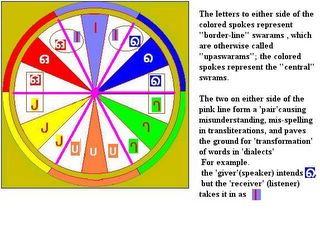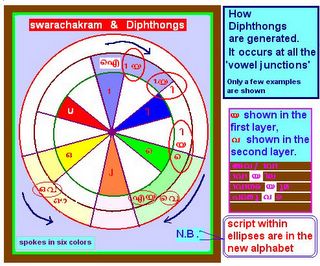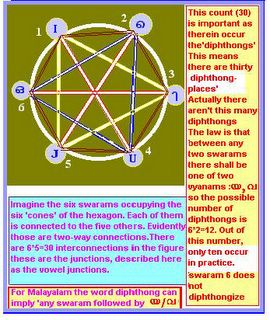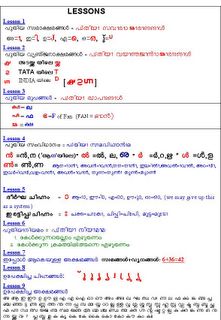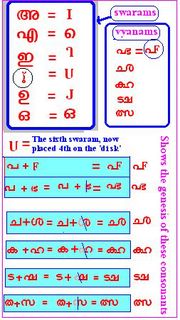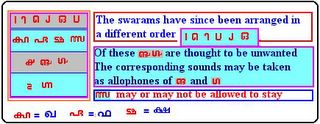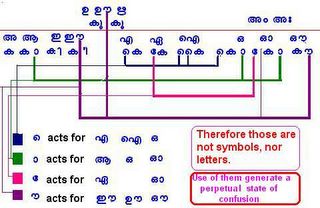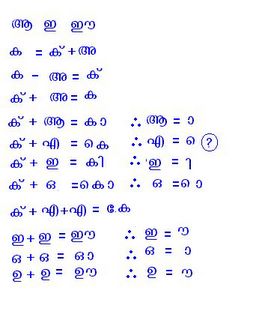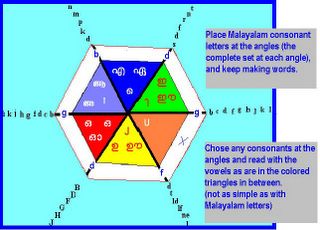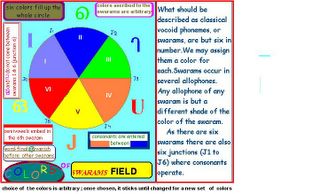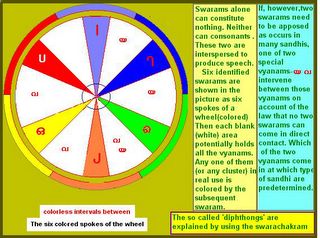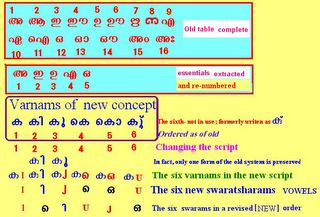Tuesday, September 20, 2005
ALPHABETIC ORDER
Order is the most fundamental requirement for anything to be intelligible, basic in any intellectual activity or function. Alphabetic order is inevitable in any list of written material, the importance of which does not need explanation.
Now how well does it work in Malayalam?
We are well aware that there is no such thing as alphabetic order in Malayalam. Guess that this may be the reason for the unending chaos, or want of ordered progress in our social or political life. The reason for failure of early development of this ordering system in our language is naturally the unsuitability of out alphabet itself. This is painfully evident in our dictionaries: Often you are not very sure of ‘where’, that is, immediately after which letter you are to look for a particular word.
For example, can every one of us recall, in a fraction of a second, and open up a fast, the word t{] m »w, if that word is in a Malayalam dictionary?*********
The problem here is great because basically, as they say, ours is a syllabic system of writing- we write, sort of, syllables (also called atsharams) and their number is so vast we cannot get at them in a quick order. The total number of possible syllables is unmanageable when you intend to order them ‘alphabetically’. We do not have an alphabet in the true sense; that is what it means. All the same, we perfectly recognize the great importance of alphabetic ordering, so we resort to the English alphabet. This is happening ever since Malayalees learned English, and we are indebted.
How about it if we now have an alphabet, with 42 characters (letters) that behave like an alphabet? Try comparing the resulting situation with the now prevalent one.
ORDER AND RECALL
We have not studied much about the ‘recall mechanism’ of mind; at least, the average people do not have much knowledge about any such mechanism, even though they all have it functioning within them. We as ordinary persons can do with some inklings about it; some tips, perhaps.
Suppose we know to recite the English alphabet without any mistake, and we know the total number of letters in the alphabet is twenty-six. Now, look at three questions; they must all be answered the moment each one is read:
1. Which is the first letter of English alphabet?
2. Which is the nineteenth letter?
3. Which is the last letter?
[Assess for yourself, the success percentage]
Now answer another set of three questions:
1. Which is the letter before M?
2. Which is the letter after M?
3. Which are the letters before and after P?
The statistics of success in this test is likely to tell the greatest success rate. Why?
The mechanism of recall works like a torch flashed, focused on a point in the past. If it is a point on a list or a series or sequence, the torch does light up a point behind and a point ‘after’ the focal point. In other situations, the torch throws light on any one circle or another, of points around the focus; if not it shows up a sequence or series (starting) ahead from the focal point.
This discussion could be stretched to any length in order to establish that in Malayalam there is neither an ordered alphabet nor an alphabetic order!! However, there seems to be no such need for over-exertion.
WE ARE GOING TO ACHIEVE THESE WITH OUR MILLENNIUM ALPHABET!!!
Order is the most fundamental requirement for anything to be intelligible, basic in any intellectual activity or function. Alphabetic order is inevitable in any list of written material, the importance of which does not need explanation.
Now how well does it work in Malayalam?
We are well aware that there is no such thing as alphabetic order in Malayalam. Guess that this may be the reason for the unending chaos, or want of ordered progress in our social or political life. The reason for failure of early development of this ordering system in our language is naturally the unsuitability of out alphabet itself. This is painfully evident in our dictionaries: Often you are not very sure of ‘where’, that is, immediately after which letter you are to look for a particular word.
For example, can every one of us recall, in a fraction of a second, and open up a fast, the word t{] m »w, if that word is in a Malayalam dictionary?*********
The problem here is great because basically, as they say, ours is a syllabic system of writing- we write, sort of, syllables (also called atsharams) and their number is so vast we cannot get at them in a quick order. The total number of possible syllables is unmanageable when you intend to order them ‘alphabetically’. We do not have an alphabet in the true sense; that is what it means. All the same, we perfectly recognize the great importance of alphabetic ordering, so we resort to the English alphabet. This is happening ever since Malayalees learned English, and we are indebted.
How about it if we now have an alphabet, with 42 characters (letters) that behave like an alphabet? Try comparing the resulting situation with the now prevalent one.
ORDER AND RECALL
We have not studied much about the ‘recall mechanism’ of mind; at least, the average people do not have much knowledge about any such mechanism, even though they all have it functioning within them. We as ordinary persons can do with some inklings about it; some tips, perhaps.
Suppose we know to recite the English alphabet without any mistake, and we know the total number of letters in the alphabet is twenty-six. Now, look at three questions; they must all be answered the moment each one is read:
1. Which is the first letter of English alphabet?
2. Which is the nineteenth letter?
3. Which is the last letter?
[Assess for yourself, the success percentage]
Now answer another set of three questions:
1. Which is the letter before M?
2. Which is the letter after M?
3. Which are the letters before and after P?
The statistics of success in this test is likely to tell the greatest success rate. Why?
The mechanism of recall works like a torch flashed, focused on a point in the past. If it is a point on a list or a series or sequence, the torch does light up a point behind and a point ‘after’ the focal point. In other situations, the torch throws light on any one circle or another, of points around the focus; if not it shows up a sequence or series (starting) ahead from the focal point.
This discussion could be stretched to any length in order to establish that in Malayalam there is neither an ordered alphabet nor an alphabetic order!! However, there seems to be no such need for over-exertion.
WE ARE GOING TO ACHIEVE THESE WITH OUR MILLENNIUM ALPHABET!!!
Sunday, September 18, 2005
Thursday, September 15, 2005
Millennium Malayalam
Writing The Quasi Swarams
We did find that there are only six Swarams, whereas there were eighteen Swaratsharams in use. We have to handle the sounds represented by thirteen of the old letters.
The “long” swarams: Repeat the letter
The diphthongs: already explained
Others are written in a consonant and a swaram as are involved in the sound.
Shortcut To The Vyanjanamaala
One need not go through the tedious study of concerned articles before one starts using the vyanjanamaala.
Carefully study the pictures to recognize the new letters. Then move to the transcriptions.
Especially use the “Lessons”
Writing The Quasi Swarams
We did find that there are only six Swarams, whereas there were eighteen Swaratsharams in use. We have to handle the sounds represented by thirteen of the old letters.
The “long” swarams: Repeat the letter
The diphthongs: already explained
Others are written in a consonant and a swaram as are involved in the sound.
Shortcut To The Vyanjanamaala
One need not go through the tedious study of concerned articles before one starts using the vyanjanamaala.
Carefully study the pictures to recognize the new letters. Then move to the transcriptions.
Especially use the “Lessons”
